|
 |
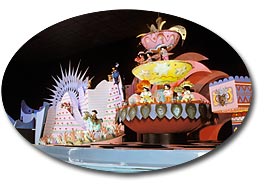 When Walt Disney introduced “it’s
a small world,” it was part of the Pepsi-Cola exhibit at the
1964 World’s Fair. Located at Flushing
Meadows Park in Queens, New York, the fair featured more than 140 pavilions
on 646 acres and offered dual themes: “Peace
through Understanding” and “Man’s Achievements on a Shrinking
Globe in an Expanding Universe.” Anyone who attended the 1964 fair and
everyone who’s ever taken a child to a Disney park knows the “small
world” song. One of its most memorable phrases is, “There’s
so much that we share that it’s time we’re aware; it’s a
small world after all.” In those
words songwriters Richard M. and Robert B. Sherman captured the essence of
Disney’s vision for the exhibit and one of the fair’s themes. Forty
years later, “it’s a small world” still emphasizes the similarities
that people around the world share, the things that make individuals from diverse
countries and cultures more alike than different. When Walt Disney introduced “it’s
a small world,” it was part of the Pepsi-Cola exhibit at the
1964 World’s Fair. Located at Flushing
Meadows Park in Queens, New York, the fair featured more than 140 pavilions
on 646 acres and offered dual themes: “Peace
through Understanding” and “Man’s Achievements on a Shrinking
Globe in an Expanding Universe.” Anyone who attended the 1964 fair and
everyone who’s ever taken a child to a Disney park knows the “small
world” song. One of its most memorable phrases is, “There’s
so much that we share that it’s time we’re aware; it’s a
small world after all.” In those
words songwriters Richard M. and Robert B. Sherman captured the essence of
Disney’s vision for the exhibit and one of the fair’s themes. Forty
years later, “it’s a small world” still emphasizes the similarities
that people around the world share, the things that make individuals from diverse
countries and cultures more alike than different.
To
the faculty in the College of Engineering, there is an even more basic
denominator, one commonality that must be explored and taught at the
undergraduate level if the world is to continue to see the kind of technological
progress in the 21st century that it witnessed throughout the 20th: life.
Every living organism employs similar biological processes to create
and sustain life. Better understanding the molecular biology of those
processes, being able to track them, model them, and some day duplicate
them, will enhance the quality of life for all the inhabitants of this shrinking
globe.”
|
 |
What
James D. Watson and Francis
H.C. Crick found as they researched,
and eventually solved, the structure of deoxyribonucleic acid (DNA)
was that “the secret of life is complementarity.” Ironically,
it was as true of their collaboration as it was of the double helix
design they unveiled in 1953. Their teamwork, as one colleague
put it, was “that of resonance between two minds -- that
high state in which 1 plus 1 does not equal 2 but more like 10.”
They
shared, as Crick said, “a mad keen to solve the problem (the
DNA structure).” The complementarity they discovered between
the adenine-thymine pair and guanine-cytosine pair in the DNA ladder
echoed the synergy of their partnership. For example, although
Crick championed the complementarity concept, it was Watson who
fit the final pieces of the puzzle together. When outlining their
findings in the journal Nature, they were also in agreement as
to whose name would come first -- a flip of a coin
was to determine the order. Finally, in closing that first groundbreaking
article, Watson and Crick served up a British understatement that
was complementary to their well-known brashness. They wrote, “It
has not escaped our notice that the specific pairing we have postulated
immediately suggests a possible copying mechanism for the genetic
material.”
Their
discovery, one of the most significant scientific breakthroughs
of the 20th century, opened the door for a better understanding
of the interactions between molecules in living systems and, thus,
a better understanding of life. In 1962 Watson and Crick received
the Nobel Prize in Physiology or Medicine “for their discoveries
concerning the molecular structure of nucleic acids and its significance
for information transfer in living material.” They shared
the honor with Maurice Wilkins of London University.
After
their discovery, Watson joined the faculty of Harvard University
and then accepted a position first as associate director and then
as director of the National Institute of Health’s fledgling
Human Genome Project. In 1992 he joined the Cold Harbor Laboratory
in Cold Spring Harbor, N.Y. Today, he is chancellor of
the Watson School of Biological Sciences at the laboratory. Crick focused his
efforts on the synthesis of proteins and the genetic code as a fellow at the
Salk Institute for Biological Studies in San Diego, Calif. He served as the
Distinguished Professor and President Emeritus of the Kieckhefer Center for
Theoretical Biology at the institute until his death on July 28, 2004.
|
|
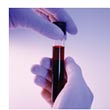 The integration of engineering
with life sciences ... from molecular to ecosystem levels ... is a
natural process. As society’s innovators engineers have always
been the “builders,” the ones who say “what if” and
then work to make a product, service, or situation better. At times
that means advancing existing technologies to better meet a need. Often
it means pioneering new technologies. The integration of engineering
with life sciences ... from molecular to ecosystem levels ... is a
natural process. As society’s innovators engineers have always
been the “builders,” the ones who say “what if” and
then work to make a product, service, or situation better. At times
that means advancing existing technologies to better meet a need. Often
it means pioneering new technologies.
Some may argue that with the
cracking of the structure of deoxyribonucleic acid (DNA) in 1953 by
James D. Watson and Francis H.C. Crick, the field of molecular (or
cellular) biology is hardly new. Others would
counter that the most dramatic benefits of that particular achievement
are yet to come and that the leaders of the next technological revolution
will be today’s engineering undergraduates as they explore and
define the field of bioengineering.
“Molecular biology,” says
Mark J. McCready, chair of the Department of Chemical and Biomolecular
Engineering, “is one of the most profound revolutions in science
and technology in the last 20 years. Two decades ago you couldn’t
effectively engineer the life sciences, because you couldn’t
write equations to accurately describe the fundamental processes of
living systems. It’s only been in the last 20 years that engineers
and biologists have been able to quantify events at the cellular level.”
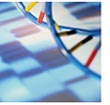 This understanding of living
organisms and the chemical operations that sustain life is pivotal
to being able to engineer biological solutions for a variety of applications,
including medical diagnostics; pharmaceuticals and drug-delivery methods; “biological” tissue
for organ implants; natural resource conservation; water quality and
treatment; soil enrichment; forest management; food growth, safety,
and preservation; and biodegradable products. The number and scope
of possible applications are as varied as the spectrum of life. This understanding of living
organisms and the chemical operations that sustain life is pivotal
to being able to engineer biological solutions for a variety of applications,
including medical diagnostics; pharmaceuticals and drug-delivery methods; “biological” tissue
for organ implants; natural resource conservation; water quality and
treatment; soil enrichment; forest management; food growth, safety,
and preservation; and biodegradable products. The number and scope
of possible applications are as varied as the spectrum of life.
Yet,
most engineering programs do not require its students to take biology
courses. In fact, the Massachusetts Institute of Technology may be
the only other university in the country that requires all of its engineering
students to take a chemical biology course.
“Before researching ways
to integrate biology into our engineering curriculum, we formed a faculty
committee,” says McCready. The curriculum committee -- Jesus
A. Izaguirre, assistant professor of computer science and engineering;
Agnes E. Ostafin, assistant professor of chemical and biomolecular
engineering; Glen L. Niebur, assistant professor of aerospace and mechanical
engineering; Ken D. Sauer, associate professor of electrical engineering;
and Jeffrey W. Talley, assistant professor of civil engineering and
geological sciences -- found that a few institutions
had been modifying their chemistry courses to include aspects of chemical
biology, but only for chemical and biomedical engineering majors.
“We didn’t want to
cut chemistry completely; it’s a fundamental aspect of engineering,” says
McCready. “On the other hand, we believed there was a distinct
advantage in requiring all engineering undergraduates to experience
a course in molecular biology. And, we’re confident that the
chemistry-molecular biology sequence we have designed, like our engineering
business program, will differentiate our graduates from students at
other institutions.
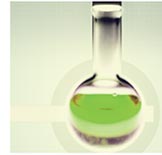 The new year-long sequence requires
undergraduates to take a traditional course in chemistry during the
first semester of the freshman year. The molecular biology course is
offered during second semester. Working closely with McCready to develop
the second course in the sequence were A.
Graham Lappin, professor
of chemistry and biochemistry, and Francis
J. Castellino, the Kleiderer-Pezold
Professor of Chemistry and Biochemistry and Director of the W.M. Keck
Center for Transgene Research. “Faculty in chemistry and biochemistry
were instrumental in helping us achieve our goals,” says McCready. “Frank
Castellino, in particular, developed an incredible course for our students
that will give them a solid grounding in the biological sciences.” The new year-long sequence requires
undergraduates to take a traditional course in chemistry during the
first semester of the freshman year. The molecular biology course is
offered during second semester. Working closely with McCready to develop
the second course in the sequence were A.
Graham Lappin, professor
of chemistry and biochemistry, and Francis
J. Castellino, the Kleiderer-Pezold
Professor of Chemistry and Biochemistry and Director of the W.M. Keck
Center for Transgene Research. “Faculty in chemistry and biochemistry
were instrumental in helping us achieve our goals,” says McCready. “Frank
Castellino, in particular, developed an incredible course for our students
that will give them a solid grounding in the biological sciences.”
“Because the basic biological
processes in all organisms are pretty much identical, says
Castellino, “I structured the class to emphasize the unity of
chemical, physical, and biological sciences.” In the course the
evolution and assembly of macromolecules into cellular structures,
as well as the interactions among cells, is stressed. Throughout
the semester, students study the origins of matter. They learn the
basic structure of the nucleus, as well as nucleosynthesis. They follow
the synthesis of heavy elements and are introduced to stable and unstable
nuclei and nuclear processes in various radioactive emissions.
Students
review human pathologies, from the natural radioactivity of potassium
to the variety of synthetic nuclides and how they are prepared and
used in the diagnostic and therapeutic applications of nuclear medicine.
They track the evolution of simple biologically relevant compounds
and carbon bonding.
Castellino also introduces protein,
DNA, and membrane structures to students. They review protein folding
and discuss the roles of simple sugars and polysaccharides in the transport,
structure, and storage of carbohydrates. Energy storage and the structure
and functions of lipids are also studied.
As the course progresses,
students learn the principles of pathogenesis and host-defense mechanisms,
including chemical intervention for the elimination of pathogens and
the development of antibiotic resistance. They study membrane fusion,
as well as passive and active diffusion -- mechanisms for the transport
of materials into and out of cells. The transduction of sensory signals
and the properties of the synapse are also covered, as are the characteristics
of enzymes, enzyme inhibitors, and the properties of chromosomes.
Largely
a lecture course, students have ample opportunity to debate the social
and ethical issues that have followed the Human Genome Project and
DNA replication. “What’s
most important,” says McCready, “is that through this course,
our students begin to understand life science fundamentals in terms
of living systems. Engineering has always been effective at describing
and designing systems. By establishing this link early in our curriculum,
our students can build on it throughout their time at Notre Dame and
see how the life sciences connect with the full range of subjects that
they study.
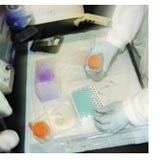 McCready believes that this “bio” revolution,
especially in the field of health care, is where the next wave of engineering
undergraduates will make the largest contributions. “Engineers
have created many products and processes that have had a profound impact
on health care -- such as drug-delivery patches and insulin pumps --
but many of the developments did not rely on molecular biology. What
if someone said, ’We want an artificial pancreas’? Engineers
would need to develop ways to sense glucose levels, create a reservoir
-- with a means of filling it, and release insulin into the body without
killing the patient. Or what about an artificial liver? Or a new heart,
not just a mechanical pump but actual biological tissue? The point
is that engineers will significantly drive the ‘bio’ revolution,
but they cannot do so without first understanding biology. This course
sequence is their introduction.” McCready believes that this “bio” revolution,
especially in the field of health care, is where the next wave of engineering
undergraduates will make the largest contributions. “Engineers
have created many products and processes that have had a profound impact
on health care -- such as drug-delivery patches and insulin pumps --
but many of the developments did not rely on molecular biology. What
if someone said, ’We want an artificial pancreas’? Engineers
would need to develop ways to sense glucose levels, create a reservoir
-- with a means of filling it, and release insulin into the body without
killing the patient. Or what about an artificial liver? Or a new heart,
not just a mechanical pump but actual biological tissue? The point
is that engineers will significantly drive the ‘bio’ revolution,
but they cannot do so without first understanding biology. This course
sequence is their introduction.”
The College of Engineering also
offers additional courses as electives, as well as a variety of opportunities
for undergraduate research in bioengineering activities.
According
to McCready, the goal of the chemistry-molecular biology course sequence
is not to lay the foundation for a degree program in “bioengineering” at
Notre Dame. Its purpose is to better prepare engineering undergraduates to be
the leaders and innovators of tomorrow, so that they can build a better
world ... big or small.
|
 |
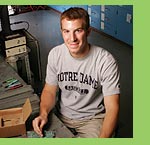 Students
in the Class of 2007 were the first engineering undergraduates
required to take the new course, Molecular Biology for Engineers. Students
in the Class of 2007 were the first engineering undergraduates
required to take the new course, Molecular Biology for Engineers.
Nathan
Stober, a chemical engineering student
from Granger, Ind., says,“The course gave me insight into
how biological and even nuclear processes are related to chemical
reactions. It also gave me an introduction to the everyday functions
of cells.”
Stober describes
the course as fast-paced but very interesting. “The most
important thing I learned from the course and Dr. Castellino [the
course instructor],” he says, “was that
a basic knowledge of chemistry is crucial to the study of almost all engineering,
scientific, or medical fields.”
In addition to
providing a strong base in biology for undergraduates, Molecular
Biology for Engineers is proving to be a stepping stone to the
wide range of bioengineering research opportunities offered throughout
the College of Engineering for these first-year students, who would
not normally have the opportunity to participate in hands-on research
until the end of their sophomore year.
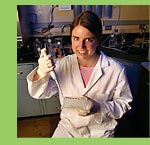 Ailis
Tweed-Kent, a classmate of Stober’s and native
of Pittsfield, Mass., is applying the knowledge she gained in the
course to her work in the Tissue Culture Laboratory. Under the direction
of Agnes
E. Ostafin, assistant professor of chemical and biomolecular
engineering, Tweed-Kent is studying osteoblasts, the bone cells responsible
for producing calcium. “The work I’m doing here is the
first step in the research process,” she says. “By
observing the morphology of the cells and using chemical assays,
we can gather information on their activity. When we have a basic
understanding of how the cells function, then we can move to the
next step in the process. Ailis
Tweed-Kent, a classmate of Stober’s and native
of Pittsfield, Mass., is applying the knowledge she gained in the
course to her work in the Tissue Culture Laboratory. Under the direction
of Agnes
E. Ostafin, assistant professor of chemical and biomolecular
engineering, Tweed-Kent is studying osteoblasts, the bone cells responsible
for producing calcium. “The work I’m doing here is the
first step in the research process,” she says. “By
observing the morphology of the cells and using chemical assays,
we can gather information on their activity. When we have a basic
understanding of how the cells function, then we can move to the
next step in the process.
|
|
 |
What
role will engineers play in the future? Consider the impact they
have had to date. Engineers are the dreamers and the doers. They
apply the “what
ifs” and make them practical and effective for commercialization. For
example, at the dawn of the Industrial Revolution, engineers took the concept
of power-driven machinery and set it into motion for manufacturing. In the
race for space, they employed their ingenuity not only to send men and machines
to the moon, but they also extended space technology to the development of
hundreds of products -- from wireless phones and heart pumps to the creation
of new metal alloys and lightweight composite materials. It’s called
technology transfer, and it’s the process through which the impact of
research and development on the marketplace is maximized.
While organizations
like the National Academy of Engineering (NAE), Honeywell International,
NEC Foundation of America, National Science Foundation (NSF), and
SBC Foundation believe that the engineers of tomorrow will continue
to identify problems and find solutions -- many of which will be
commercialized -- they are also sponsoring a two-phase initiative to identify
desired attributes of engineers in 2020. The purpose of the study is to suggest
strategies for engineering education that will better prepare students to meet
the challenges of the future.
The attributes
identified by the first phase of the study suggest that engineers
must continue to possess strong analytical skills and exhibit practical
ingenuity and creativity. They will need to be excellent communicators
who have mastered the principles of business management. These
leaders must also adhere to high ethical standards and have a strong
sense of professionalism. Many of these qualities are evident in
today’s
engineers. But, what the study has deemed imperative for future engineers is
that they be lifelong learners who are flexible and innovative. In fact, according
to the study: “The pace
of technological innovation will continue to be
rapid (most likely accelerating). The world in which technology
will be deployed will be intensely globally interconnected.
The population of individuals who are involved with or affected
by technology (e.g., designers,
manufacturers, distributors, and users) will be
increasingly diverse and multidisciplinary. Social, cultural,
political, and economic forces will continue to
shape and affect the success of technological innovation.
The presence of technology in our everyday
lives will be seamless, transparent, and more
significant than ever.”
The NAE, NSF, Honeywell, NEC,
and SBC are not the only participants in the discussion about the future of engineering
education. According to Arthur T. Johnson, professor of biological resources
engineering at the University of Maryland and author of a book and several papers
on biology for engineers, “the frantic rush to establish and enhance academic
bioengineering programs in the United States ... may also have kept bioengineering
from emerging in an orderly and thoughtful way.”
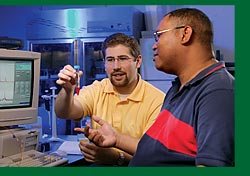 What exactly
is “bioengineering”? It’s been defined by a number
of people in a variety of ways. Some view it as specifically applying
to medicine and health care. Others describe it as anything affecting
the human organism. The National Institutes of Health defines bioengineering
as “an integration of the physical, chemical, or mathematical
sciences and engineering principles for the study of biology, medicine, behavior,
or health. It advances fundamental concepts, creating knowledge
from the molecular to the organ systems level. It develops innovative
biologies, materials, processes, implants, devices, and informatics
approaches for the prevention, diagnosis, and treatment of disease;
for patient rehabilitation; and for improving health.” But
biology also affects ecology and the environment. In fact, it is the impetus
for a multitude of bio-inspired research projects across numerous
fields. What exactly
is “bioengineering”? It’s been defined by a number
of people in a variety of ways. Some view it as specifically applying
to medicine and health care. Others describe it as anything affecting
the human organism. The National Institutes of Health defines bioengineering
as “an integration of the physical, chemical, or mathematical
sciences and engineering principles for the study of biology, medicine, behavior,
or health. It advances fundamental concepts, creating knowledge
from the molecular to the organ systems level. It develops innovative
biologies, materials, processes, implants, devices, and informatics
approaches for the prevention, diagnosis, and treatment of disease;
for patient rehabilitation; and for improving health.” But
biology also affects ecology and the environment. In fact, it is the impetus
for a multitude of bio-inspired research projects across numerous
fields.
Johnson believes
that “all engineers these days should know something about
biology.” They should have a broad understanding of biological
principles, be able to apply the information known about “familiar
living systems” to
those of less familiar or unknown systems. They also need to be willing to
work in collaborative teams, whose members offer a variety of skills
and approaches.
His recommendation
for a successful undergraduate engineering curriculum is one that
offers “basic instruction in physics, mathematics, chemistry,
biology, and engineering. Students should be able to view the full
horizon of potential biological applications, from subcellular
to ecological levels.” This corresponds to the approach the
College of Engineering has taken in developing its new chemistry-molecular
biology course sequence for undergraduates.
|
|
|
|




